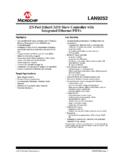Transcription of Regional Strategy and Framework of Action for Addressing ...
1 Regional Strategy and Framework of Action for Addressing Gender Based Violence 2018 - 2030. Approved by SADC Ministers of Gender and Women's Affairs in July 2018. 1. Table of Contents Acronyms .. 4. Foreword .. 5. Acknowledgement .. 7. 1. Background Information .. 8. Introduction .. 8. Global and Regional Commitments on GBV .. 9. 2. Situational Analysis of GBV in the SADC Region .. 11. The Extent of the Problem at Global Level .. 12. GBV Prevalence in the SADC Region .. 12. Causes of 13. The GBV Response in the SADC Region .. 13. Raised GBV awareness .. 14. Legislation for GBV prevention and protection of victims .. 14. GBV Services .. 14. Coordination, Monitoring and 14. Challenges to Effective GBV Response .. 15. 3. SADC GBV Strategy Orientation .. 16. Justification for a Regional GBV Strategy and Framework for Action .. 16. Strategy 17. 17. Strategy Principles and Guiding Lessons .. 18. Strategy Thematic Areas .. 19. 4. SADC GBV Strategy 19. Discussion of Thematic Programming Areas.
2 20. Prevention of GBV .. 20. Protection, Care and Support Services .. 21. Capacity 22. Information and Knowledge Management, including Good Practices and Innovation .. 23. Coordination, Networking and 24. Special Areas of 25. Engaging Men and Boys in Prevention and Mitigation of GBV .. 25. GBV in Conflict Situations .. 26. Resource Mobilization .. 26. 5. Coordination, Monitoring and Evaluation of the Regional GBV Strategy .. 27. Areas of emphasis .. 27. Member States Reporting and GBV Strategy Evaluation .. 28. 2. Annexure A: SADC Regional Framework of Action for Addressing Gender Based Violence Annexure B: Gender Based Violence Indicator Description Annexure C: Guidance on Monitoring and Evaluation for Gender Based Violence Interventions Annexure D: Case Studies - Emerging Models of Good/Best Practice on Gender Based Violence 3. Acronyms AGDI African Gender Development Index BPfA Beijing Platform for Action CBO Community-Based Organization CEDAW Convention on the Elimination of all forms of Discrimination against Women CM Coordination Mechanism CRC Convention on the Rights of the Child DOVIS Domestic Violence Information System DRC Democratic Republic of Congo ECOSOC Economic and Social Council FBO Faith-Based Organization FSBx Family Support Bureaux FWPU Family Welfare and Protection Unit GAC Gender Advisory Committee GBV Gender Based Violence GBVRS Gender Based Violence Referral System GDP Gross National Product HIV Human immunodeficiency virus HT Human Trafficking ICPD International Conference on Population and Development IPV Intimate Partner Violence LTFU Loss-To-Follow-Up M&E Monitoring and Evaluation MCO Ministerial Committee of the Organ MGECDFW Ministry of Gender Equality.
3 Child Development and Family Welfare MS Member State NGO Non-Governmental Organization NGPTF National Gender Permanent Task Force NSA Non-State Actor RBM Results Based Management SADC Southern Africa Development Community SIPO Strategic Indicative Plan for the Organ on Politics Defence and Security Cooperation SRH Sexual Reproductive Health STDs Sexually transmitted Diseases SV Sexual Violence UNDP United Nations Development Programme UNECA United Nations Economic Commission for Africa UNFPA United Nations Population Fund USAID United States Agency for International Development VAW Violence Against Women WHO World Health Organization 4. Foreword Peace and security have always been central to the Southern Africa Development Community (SADC)'s Regional integration agenda. In spite of this, Gender based violence (GBV) continues to be a threat to human security, peace and development. The SADC blueprint documents, namely the Revised Regional Indicative Strategic Development Plan 2015-2020 (RISDP) and the Strategic Indicative Plan of the Organ on Politics, Defence and Security Cooperation (SIPO) recognise the prevention and reduction of GBV as a catalyst for attaining serene peace and security conducive environment.
4 Also, the revised RISDP explicitly includes the development of the Regional GBV. Strategy as one of its priorities. Furthermore, the SADC Protocol on Gender and Development which entered into force in 2013 and revised in 2016, clearly identifies GBV as an area of concern and has proposed several approaches which have been codified in this GBV Strategy . In addition, the SADC Gender policy explicitly suggests that SADC's approach of Addressing GBV should go beyond just looking at the act of violence; but to also consider the need to develop evidence- based strategies that encompass education, prevention and victim assistance. In light of the above, Ministers responsible for Gender and Women's Affairs resolved that in order to address the absence of a Regional Strategy on GBV, Secretariat should facilitate the development of a Regional Strategy and Framework of Action for Addressing Gender Based Violence. The development of this Regional Strategy aims to facilitate the implementation and monitoring of the SADC Protocol on Gender and Development, Part 6 on Gender Based Violence, Articles 20-25, in line with the target of reducing GBV incidences by half by Strategy serves to identify priority areas of Action based on these Articles and guided by the broader key programming areas on GBV.
5 The Gender Protocol therefore provides a context within which the SADC community should strategically direct the development of their anti-GBV programmes. I. am therefore pleased to present the SADC Gender Based Violence Strategy and its Framework of Action 2018-2030 which was approved by the SADC Ministers responsible for Gender Equality and Women's Affairs in Pretoria, South Africa in July 2018. The SADC GBV Strategy is aligned to relevant Regional , continental and international gender and GBV instruments. Despite the persistent and continuous effort to address GBV in the region and globally, with policies and legal frameworks in place, this epidemic continues to worsen and claim the lives of innocent people, particularly women and girls in the Region. Gender based violence is among the most severe and widespread human rights violations in Southern Africa. Globally 1 in 3 women have experienced GBV at some point in their lives, and in the Region some countries register levels that are even higher than the global average.
6 SADC, like other regions, faces different challenges in the response to GBV including among others ineffective prevention initiatives, under-reporting of GBV cases, impunity, inadequate coordination and implementation of policies and laws. The GBV epidemic is a serious impediment for efforts to achieve national, Regional , 5. continental and global development goals. In this regard, Addressing GBV requires strengthening of prevention efforts and collective Action of all key sectors at national to international levels, to implement effective prevention, protection, care and support programmes. The Regional Strategy therefore provides for an effective holistic and coordinated approach to Addressing GBV in the Region. It serves to stimulate Regional interventions for harmonization of GBV response efforts by all SADC Member States. The Strategy emphasizes the need for SADC. and its Member States to strengthen effective GBV prevention and mitigation programmes. This includes initiatives that highlight the role of local communities in the review, repeal and change of harmful and negative cultural norms and practices perpetuating GBV and forging of strong partnerships between Governments, civil society and the private sector in responding to the socio-economic impacts of this social ill.
7 The success of the GBV Strategy will depend on a broad- based partnership in society in which Member States consult and act cooperatively with other stakeholders. The Strategy is anchored on five main thematic areas of focus as follows: Prevention of GBV; Protection, Care and Support Services; Capacity Development; Information and Knowledge Management, including Best Practices and Innovation; and Coordination, Networking and Partnerships. On behalf of the SADC Secretariat, I would like to express our gratitude that indeed, it is evident that the development of the SADC GBV Strategy has immensely benefitted from the collaborative visionary and transformative leadership provided by SADC Ministers responsible for Gender and Women's Affairs, stakeholders and partners. This demonstrates strong commitment to this Strategy and its Framework of Action to ascertain that all the countries move together in tandem to the envisaged common future of a peaceful and secure region where no one is left behind.
8 Dr. Stergomena L. Tax SADC EXECUTIVE SECRETARY. JULY 2018. 6. Acknowledgement The SADC Secretariat is grateful to the leadership of the SADC Ministers of Gender and Women's Affairs, under the Chairmanship of Honorable Minister Bathabile Dlamini of the Ministry of Women in the Presidency, Republic of South Africa, for their leadership in the development of the SADC Gender Based Violence Strategy and its Framework of Action . The contribution by Member States and all relevant different stakeholders, from providing relevant country information to validating the Strategy , is duly acknowledged and appreciated. We are equally grateful to UN Women South Africa Multi-Country Office (SA MCO), in collaboration with the Embassy of Ireland in South Africa, for their strategic financial support to the development of this Regional Strategy . The Strategy was developed through a consultative and inclusive process. In addition to input from Member States, other strategic partners were engaged to offer their Regional and international experiences in Addressing GBV.
9 Key partners that provided valuable input include GIZ, UNODC, UN Women SA MCO, UNFPA, and Sonke Gender Justice. We are grateful to the lead Consultant Ms. Valencia Diba Mogegeh, who diligently facilitated the development of this Strategy . She offered her technical and administrative expertise to successfully lead this process and was also very accommodative of guidance and input from all the contributors. Ms. Mogegeh was supported by Ms. Kealeboga Kelly Dambuza who provided additional technical expertise in the development of this Strategy . Appreciation should also go to the SADC Secretariat staff under the Gender Unit, led by Dr. Joseph Pitso, for their effective coordination of this process. Other SADC staff from other Directorates and Units also provided valuable input in this Strategy . 7. 1. Background Information Introduction Gender based violence (GBV) has increasingly gained global attention over the past forty to fifty years. Focused studies continue to be conducted including in the SADC region; to understand the nature, prevalence as well as causes and consequences of GBV in all spheres of life.
10 These studies also often seek to evaluate the effectiveness of current strategies; with a view to improve GBV. prevention and mitigation interventions. Advocacy efforts by gender activists and feminists have also increased over time, primarily unpacking patriarchy and its adversative impact on gender equality. This is often seen through negative cultural and religious practices that encourage oppressive unequal treatment of women and girls compared to men and boys. Examples here include early and usually arranged marriages for girls. Gender advocacy has also been directed at exposing inadequacies, for instance; in the judicial system that often result in impunity or sentences for perpetrators that do not reflect the gravity of committed GBV offences. However the gains made in the prevention and mitigation against GBV are generally slow to realize and often fragile, with a strong likelihood of being reversed because of: lack of in-depth knowledge on GBV as an area of concern to the family and the community as a whole and a serious public health risk; stigmatization; limited services due to regulated facilities ( , fixed operating hours for health facilities); limited knowledge and negative attitudes of service providers; and over- regulated procedures that do not facilitate expediency in providing services to GBV victims.















